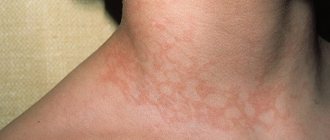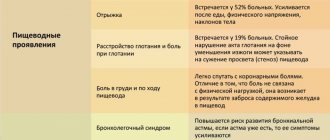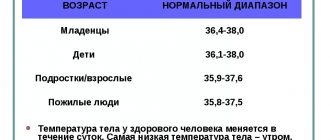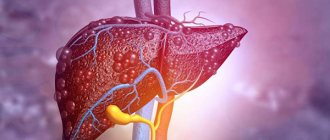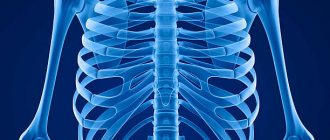The norm is considered to be a general body temperature of +36 to +37°C. A periodic decrease to +35.5°C is possible with hypotension, hypothermia and some infections. Usually this condition normalizes on its own over time. But there are situations where hypothermia is very dangerous.
Nervous and physical exhaustion
High physical activity, prolonged stress, lack of sleep, poor diet and strict diets often lead to a deficiency of the body’s energy resources. As a result: metabolism slows down, blood circulation slows down and the temperature drops below normal by 1-2 degrees. The pathological condition is accompanied by significant weight loss, apathy, weakness, fatigue, depressed mood or increased nervous excitability. There may be frequent headaches and decreased mental abilities. The person becomes distracted and inhibited. There is a weakened immune system and hypovitaminosis.
With physical and nervous exhaustion, body temperature steadily decreases to +35–35.5°C. The condition is accompanied by chills even in warm weather. This pathology is usually not life-threatening, but it is an alarming sign that requires urgent lifestyle changes.
If the thermometer is above 36.6 degrees C
Situations with low temperatures in clinical practice are much less common than indicators above 36.6 degrees C. Many modern people have come to regard moderately elevated indicators (low-grade fever) as a necessary condition for the body’s fight against infection. That is, if the temperature does not exceed 380, today there is no rush to bring it down, realizing that as the degrees rise, the body’s protective functions improve.
Still, you should not sit idly by at elevated (above 37.1) temperatures. This is a signal about a developing inflammatory process, which means that the body needs to help cope with it:
- if there are obvious signs of a cold, provide plenty of warm drinks, rinse the throat and nose with a saline solution, and ventilate the patient’s room;
- if you have acute pain (head, stomach, ears), consult a doctor;
- If there are signs of intoxication (nausea, vomiting, diarrhea), call an ambulance.
In a situation where the temperature remains at a low-grade level for weeks or months, it is also necessary to see a doctor and undergo an examination, since tuberculosis, endocrine or tumor diseases may be hidden behind this symptom.
If the temperature is above 36.6 degrees, but does not exceed 37.10 C, there is no reason to worry.
Post-viral syndrome
In this case, the body temperature usually stays around +35.5°C or +35°C for several days. In the fight against infections, the body spends a lot of internal resources, suffers from the consequences of intoxication and microbial aggression, which is why many functions, including thermoregulation, are disrupted. The early period of recovery is often accompanied by a decrease in temperature. The condition is accompanied by other symptoms: physical weakness, bad mood, drowsiness, decreased concentration. Shortness of breath may occur, worsening with exertion and stress. Children, adolescents, and people with chronic vascular and central nervous system diseases are susceptible to pathology.
Reduced body temperature
Iron deficiency
49639 09 February
IMPORTANT!
The information in this section cannot be used for self-diagnosis and self-treatment.
In case of pain or other exacerbation of the disease, diagnostic tests should be prescribed only by the attending physician. To make a diagnosis and properly prescribe treatment, you should contact your doctor. Low body temperature: causes of occurrence, what diseases it occurs with, diagnosis and treatment methods.
Definition
Low body temperature, or hypothermia, is a disorder of heat metabolism, manifested by a decrease in body temperature due to exposure to low temperatures and/or a decrease in heat production and an increase in heat output.
There are several mechanisms for active heat production.
Mandatory heat production
- heat produced as a result of normal physiological and metabolic processes. It is enough to maintain normal body temperature in a comfortable ambient temperature.
Additional heat production
activates when the ambient temperature drops and includes:
- non-contractile thermogenesis
, which is carried out by the breakdown of brown fat. Brown fat is present in large quantities in newborns and protects them from hypothermia. In adults there is little of it, it is localized in the neck, between the shoulder blades, near the kidneys; - contractile thermogenesis
, which is based on muscle contraction.
When the body becomes hypothermic, muscle tone (tension) increases and involuntary muscle tremors appear.
Passive heat retention is carried out using subcutaneous fatty tissue.
The rate of metabolic processes and adaptation reactions is influenced by hormones of the adrenal glands and thyroid gland, and the center of thermoregulation is located in the hypothalamus.
For a person, the comfort zone is considered to be the air temperature range from +18°C to +22°C, subject to light clothing and normal physical activity.
There is a distinction between central body temperature (maintained in the internal organs and central vessels at 36.1–38.2°C) and the temperature of peripheral tissues (extremities, body surface) - normally it is tenths of a degree lower than the central temperature.
Central body temperature is measured in the rectum, external auditory canal, and mouth. In a medical facility, it is possible to measure temperature in the lumen of the esophagus, in the nasopharynx, and in the bladder. Peripheral temperature can be measured on the forehead or armpits.
In general, body temperature indicators are individual and each location has its own normal range. Body temperature changes throughout the day. Due to the intensity of metabolic processes, young children have a higher normal temperature level. The metabolism of older people is slow; the internal temperature can normally be at 34–35°C.
Varieties of low temperature
A decrease in temperature can be endogenous (with pathology of internal organs and imperfect thermogenesis) and exogenous (depending on environmental conditions).
An exogenous decrease in temperature includes drug-induced hypothermia. Its task is to reduce the functional activity and metabolism in organs and tissues in order to increase their resistance to oxygen deficiency. It is used in the form of general controlled hypothermia when there is a need to temporarily slow blood circulation; and local controlled hypothermia of individual organs and tissues.
Drug hypothermia is used during open operations on the heart and large vessels, for ischemic stroke, injuries of the central nervous system (brain and spinal cord), and for severe oxygen starvation of newborns.
The severity of a person’s condition is assessed by the level of decrease in core temperature and clinical manifestations.
At a low temperature (36.5–35°C) a person can feel quite well. It follows from this that she is a variant of the norm for him. If a person feels unwell, it is necessary to look for the cause of the drop in temperature.
Body temperature below 35°C is considered low.
Low temperature is detected:
- mild severity (35.0–32.2°C)
, in which drowsiness, increased breathing, heart rate, and chills are observed; - moderate severity (32.1–27°C)
– a person may become delirious, breathing slows down, the heartbeat slows down, reflexes decrease (reaction to an external stimulus); - severe severity (below 27°C)
- a person is in an extreme degree of depression of consciousness (in a coma), blood pressure is reduced, reflexes are absent, deep disturbances in breathing and heart rhythm are noted, the balance of the internal environment of the body and all metabolic processes are disturbed.
Possible causes of low temperature
Possible causes of hypothermia include:
- damage to the central nervous system;
- decreased muscle mass;
- physical fatigue;
- decrease in the speed of metabolic processes;
- pregnancy;
- period of convalescence after a protracted illness;
- dysregulation of vascular tone;
- various intoxications, including alcohol;
- exposure to medications, including overdose of antipyretics;
- intravenous infusion of large volumes of unheated solutions;
- hypothermia in conditions of low air temperature;
- prolonged exposure to wet or damp clothing;
- prolonged exposure to cold water, on cold objects, etc.
All of the above factors can lead to disruption of thermoregulation, decreased heat production, and increased heat loss.
What diseases cause low temperature?
Body temperature can decrease with paresis and paralysis of muscles and/or a decrease in their mass that occurs due to diseases (syringomyelia) and spinal cord injuries, damage to the nerve fibers innervating the muscles, calcium deficiency, hereditary diseases (Erb-Roth muscular dystrophy, Duchenne).
A slowdown in metabolism occurs with chronic insufficient function of the adrenal glands (for example, in autoimmune processes) and the thyroid gland (hypothyroidism), diffuse diseases of the liver, kidneys, with a significant decrease in glucose levels (hypoglycemia), with reduced hemoglobin and/or a decrease in the number of red blood cells (anemia) , with insufficient nutrition, severe exhaustion (cachexia) and thinning of subcutaneous fat.
Violation of thermoregulation is observed with traumatic, medicinal or toxic effects on the hypothalamus.
Hypothermia can occur with extensive multiple trauma or during a systemic infectious process (sepsis).
Which doctors should I contact if I have a low body temperature?
To save a person with severe hypothermia, an emergency medical team must be called.
If a person has recorded a decrease in body temperature by 1–2°C in relation to his individual norm, this condition persists for a long time and is not associated with hypothermia, he should consult a therapist, and, if necessary, a neurologist or endocrinologist.
Diagnostics and examinations for low body temperature
Diagnosis of low body temperature consists of examining and interviewing the patient, measuring body temperature and blood pressure, and assessing blood oxygen saturation (pulse oximetry, blood gas testing).
To identify disturbances in the functioning of organs and systems, the following laboratory and instrumental studies may be prescribed:
- clinical blood test;
Low blood glucose
Hypoglycemia due to prolonged hunger and excess insulin provokes energy starvation of the brain, slows blood circulation and metabolism. As a result of glucose deficiency, physical weakness develops, dizziness, and attacks of hunger. With a prolonged lack of sugar in the blood, coordination of movements is impaired, asthenia sets in, the body breaks out in cold sweat, and body temperature drops to +35°C. In the absence of outside help to the body, fainting and hypoglycemic coma are possible. People of any age are susceptible to pathology; insulin-dependent patients suffer more often than others.
Internal hemorrhage
Internal bleeding may be caused by damage to blood vessels. In turn, it can be caused by the progression of peptic ulcer disease, tumor growth, disturbances in the functioning of the cardiovascular system, and increased fragility of the vascular walls.
Also, internal bleeding can be caused by problems in the endocrine system and diseases associated with metabolism.
The chronic form of internal hemorrhage can occur without significant symptoms.
A feeling of fatigue, characteristic diseases that may be indicated by the patient's medical history, pale skin and drowsiness may be signs of hemorrhage. In case of injury or bruises of internal organs, hypothermia indicates the need for specialist help. If the patient loses consciousness, you should not hesitate under any circumstances; urgent hospitalization is necessary.
Help with hypothermia
Immediate measures: exposure to heat, elimination of hunger, neutralization of toxins. A person with hypothermia is advised to drink hot tea, take a bath, and wrap himself in a thick blanket. In critical conditions, hospitalization is required.
The exact causes of the pathological symptom are determined by the therapist or doctors of other profiles. Diagnostics includes biochemical and hormonal blood tests, ECG, ultrasound of internal organs, computed tomography or MRI of the spine and brain. A complete medical examination helps to identify the most unexpected causes of low temperature.
Drug therapy depends on the established diagnosis. These can be antibiotics, immunomodulators, antidepressants, nootropics. To consolidate the results of treatment, the doctor usually recommends purchasing vitamin and mineral complexes.
Treatment
Help before diagnosis
If the body temperature is more than 32°, you can get by with passive warming. The person is wrapped in heated blankets or placed in a bath with warm water and given hot tea. With prolonged hypothermia and satisfactory condition during the convalescence period, specific treatment is not required - sleep 8-10 hours a day, increased calorie intake, and adequate rest are recommended. If the reasons for the detected low temperature are unclear, consult a doctor.
First aid for hypothermia
Conservative therapy
At critically low temperatures, active warming is effective: heat fans and heating pads, inhalation of warm humidified oxygen and intravenous infusion of heated solutions. In emergency situations, warm lavage and extracorporeal blood purification methods are used. For etiotropic and pathogenetic treatment of diseases accompanied by a drop in human body temperature below 36 degrees, the following are prescribed:
- Vitamins
. With general exhaustion of the body, B vitamins are indicated, which enhance neuromuscular transmission and improve the trophism of nervous tissue. Alpha tocopherol is used as a powerful antioxidant. For severe weakness, glucose solutions with vitamin C are administered. - Hormones
. Replacement therapy with levothyroxine allows you to accelerate the processes of metabolism and thermogenesis, and restore normal body temperature. In case of Addison's disease, cortisol preparations are necessary; in case of a lack of mineralocorticoids, aldosterone is additionally administered. - Cardiotropic drugs
. Medicines stimulate cardiac activity in shock and other critical conditions, normalize cardiac output and increase blood pressure. The drugs of choice for emergency care are solutions of adrenaline or dobutamine; in hospital therapy is supplemented with glycosides. - Antidepressants
. The medications are serotonin receptor agonists and improve neural connections between different parts of the brain. Temperature normalization occurs due to stimulation of the hypothalamic center and increased contractile thermogenesis. - Antibiotics
. Hypothermia often masks the manifestations of a severe bacterial infection, so broad-spectrum antibiotics are indicated for very low body temperatures. Medicines are administered intravenously until temperature values normalize and general condition improves. - Antidotes
. For acute signs of intoxication, universal drugs are used that bind or destroy various toxic substances. In cases of heavy metal poisoning and drug overdose, unithiol is effective.
When is urgent medical attention needed?
- The thermometer shows 35°C, and the temperature continues to fall.
- A decrease in temperature is accompanied by bleeding, vomiting, speech and vision disturbances, loss of consciousness, hallucinations, severe yellowing of the skin and whites of the eyes.
- The temperature is reduced in a child or an elderly person and is combined with general poor health.
- There are signs of hypothermia: pale skin, bluish nasolabial triangle, chills, shortness of breath, rapid pulse, lethargy.
- Low temperature is especially dangerous for elderly and seriously ill people.
Low temperature with ARVI
An increase in temperature is usually associated with respiratory viral infections. There are two possible causes of hypothermia during colds. In the first case, this is caused by a weakening of the body after suffering from a fever; usually this condition is accompanied by a loss of strength and high drowsiness. Since the immune system spends a lot of energy defending against the virus, after the temperature rises there will be a period of its decline, sometimes to unusually low values.
The absence of fever during a cold in an adult is an alarming sign.
The second cause of hypothermia during ARVI may be the lack of an immune response.
In this case, the body requires comprehensive external support, which must be provided both by taking antiviral drugs and by other methods. It is imperative to provide the patient with plenty of fluids, easily digestible food, complete rest and warmth. If the body cannot independently raise the temperature to suppress the virus, you can help it by wrapping the patient as warmly as possible.
Differential diagnosis
A body temperature of 36 in an adult (the cause may be related to the presence of serious diseases) often indicates possible pathologies in the body. Therefore, it is recommended to carry out differential diagnosis. This method allows you to establish an accurate diagnosis based on a set of other symptoms.
Diagnostics is carried out in 3 stages:
- First, the patient’s medical history is carefully studied and the reasons for the appearance of low temperature (for example, hypothermia) are determined.
- At the 2nd stage, a direct examination of the patient is carried out, and concomitant symptoms are also studied in detail.
- The final step is to conduct laboratory and other tests to confirm a particular diagnosis.
How to improve your performance
Body temperature of 36 °C in an adult, regardless of the reason for the decrease, can be increased in various ways: from traditional methods to the use of medications. But if this decrease is accompanied by unpleasant symptoms, you should not self-medicate - you should immediately seek medical help.
Methods for emergency temperature rise
One of the emergency methods of raising the temperature is inhaling alcohol. To do this, soak a cotton swab with liquid. The sensations during this process will be unpleasant, but it gives quick results.
The main thing is not to bring alcohol too close to your nose, so as not to cause a burn to the mucous membranes. Another way is to rub the body with vinegar. After this, you need to immediately wrap yourself in a blanket. This will help raise the temperature by 1-2 °C, but can lead to acetic acid poisoning.
Other ways that can also be harmful to health are:
- Take a few drops of iodine orally. It is recommended to first drip it onto bread or sugar. If the tincture is taken in its pure form, it can cause burns to the mucous membranes and severe poisoning.
- Eat 2-3 tsp. instant coffee granules without drinking water.
- Eat graphite from a simple pencil without chewing. When using colored pencils, the likelihood of poisoning from toxic substances contained in the dye increases.
These methods are used mainly when it is necessary to artificially increase the temperature - for example, in order not to go to classes at school, college, etc. They can be harmful to health, so using such options is not recommended.
Medications
Medicines and methods used at low temperatures are presented in the table below.
| Drugs, manipulations | Features of application |
| Saline and glucose (5%) | The solution is heated and administered intravenously |
| Inhalation of warm humidified oxygen | Carried out through a special oxygen mask |
| Introduction of special warm solutions | The liquid is heated to 44 °C and injected through a catheter |
| Peritoneal lavage | The abdominal cavity is irrigated with a warm isotonic solution. |
| Endogenous pyrotine hormone | After the substance enters the brain, nerve cells begin to contract, which provokes the production of more heat. |
Usually, when body temperature drops to 36 °C, manipulations are sufficient to externally warm the person.
These passive methods include:
- placing a person in a warm, comfortable room;
- inhalation of warm air;
- putting on warm clothes.
During these actions, the head must be covered, because 30% of the heat transfer occurs through it. These simple measures help quickly restore the body's thermoregulation function.
If necessary, active heating methods are used:
- Use of infrared radiation (reflectors).
- Warm baths.
- Electrically heated blankets.
Traditional methods
You can also raise the temperature using traditional methods.
The most popular methods are:
- Carrying out mustard baths. To do this, you need to dilute dry mustard in water and keep your feet in the resulting solution for half an hour.
- Ingestion of a decoction of echinacea, rose hips or St. John's wort. They must be drunk warm. To improve the taste, you can add honey to the drink.
- If a person has cold hands and feet, you can rub them and put warm clothes on top.
- Adding hot cayenne pepper to dishes. It is recommended to add ¼ tsp. every day. The increase in body temperature occurs due to the content of the substance capsaicin in the product during the digestion of pepper.
- Eating raw ginger. To increase the temperature, it is enough to eat a small piece (the size of a finger) of the root. An alternative could be ginger drink. To prepare it, a piece of ginger needs to be boiled for 5-10 minutes in water. Prepared tea should be consumed warm. Its action is based on stimulating the functioning of the digestive organs.
- Consumption of foods that are rich in fats, carbohydrates and proteins. To digest them, the body has to expend more energy and, therefore, the body heats up, increasing the temperature.
other methods
The simplest ways to increase the temperature at home include:
- Doing physical exercise. For example, you can jump or squat. To enhance the effect, you can wear several layers of clothing. It is important to drink enough water during exercise to avoid dehydration.
- Drinking hot drinks or hot food. You can also eat a delicious mixture of banana, chocolate and honey to raise your temperature.
- Wrap your body in warm material that retains heat well (for example, fleece).
- Put warm clothes on a person with a low temperature - mittens, a scarf, a hat, and drink hot tea.
- Wear several layers of clothing.
- Apply a heating pad. You need to add warm, but not too hot water, wrap yourself in warm clothes, lie under a blanket and take a heating pad with you.
- Take vitamin C, Corvalol or motherwort tincture. These drugs increase vascular tone, but they are not recommended to be abused.
A body temperature of 36 °C may indicate health problems in an adult. If other symptoms of deterioration in well-being are observed, it is recommended to consult a doctor.
In the evenings
If a person’s temperature often jumps from 36 to 37 degrees in the evenings, this may indicate the development of chronic diseases. These include:
- Pharyngitis.
- Sinusitis.
- Pyelonephritis.
- Salpingo-oophoritis.
These pathologies are accompanied by very unpleasant symptoms, so you should not hesitate to treat them. The patient must undergo a medical examination at the clinic, after which, based on the tests, the specialist prescribes the most suitable medicine.
How can hypothermia manifest?
It is necessary to measure your temperature if you notice the following symptoms:
- increased fatigue and drowsiness, which is difficult to cope with on your own;
- feeling overwhelmed;
- nervousness, irritability;
- you find it difficult to concentrate.
Children with low body temperature experience tearfulness, lethargy, moodiness, and lack of appetite.
Do not forget that the objectivity of the thermometer readings largely depends on the time of day, age and even the location of measurement. For example, in the morning, after sleep and long rest, body temperature is always slightly lower than usual.

